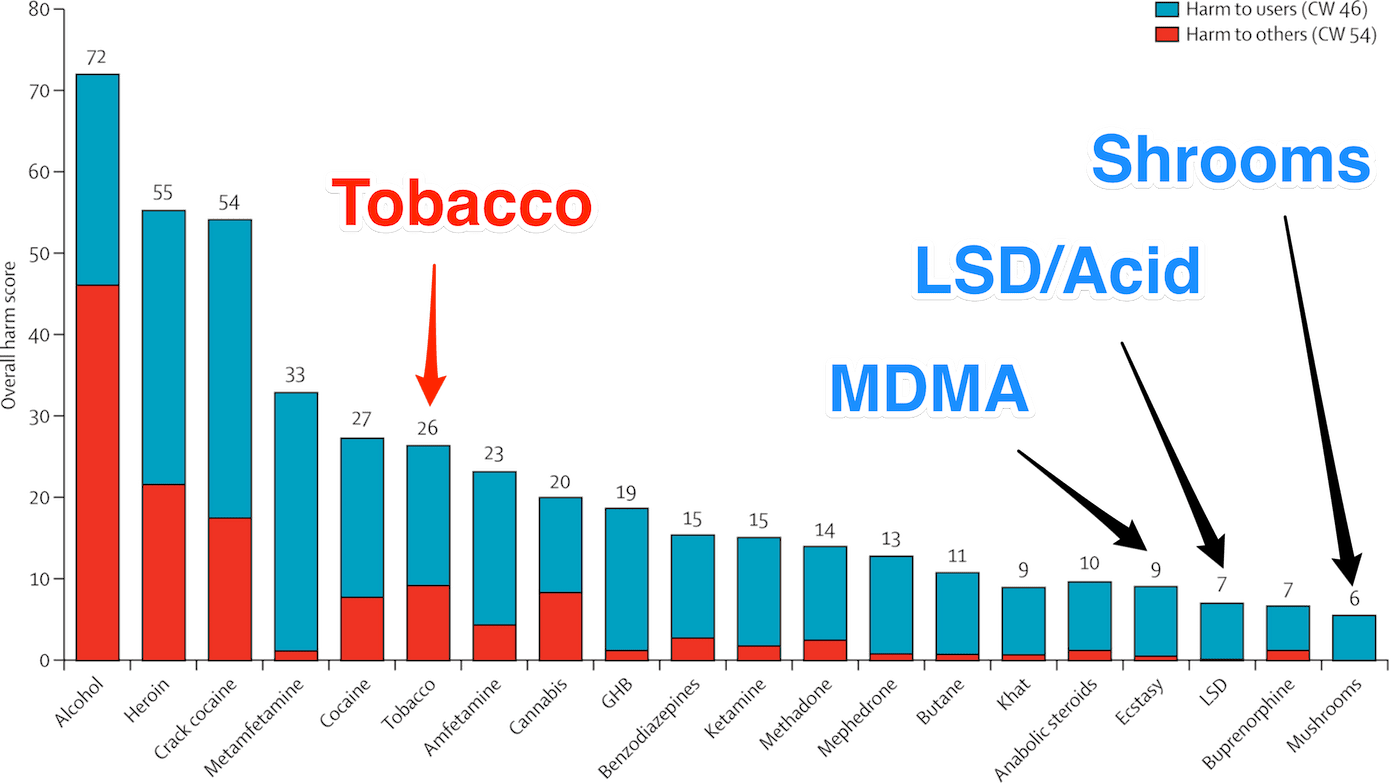1. Are shrooms bad for you?
A research paper ranked psilocybin mushrooms as the third safest drug (Nutt et al). All drugs can still be harmful under certain circumstances.1 A separate study also found that magic mushrooms were the drug with the lowest rate of emergency room visits after use, lower than alcohol, and even marijuana.2

From the page on Shrooms.
2. Psilocybin, an active ingredient in magic mushrooms, has an excellent safety track record to date in lab studies
The biggest risk to organs of magic mushrooms is eating a poisonous mushroom that isn’t actually a psilocybin mushroom.3
There is a question around whether long term frequent use, for example in weekly microdosing, could have cardiac effects, and more information is needed.
Be extra careful if you’re picking your own mushrooms to avoid poisonous mushrooms. Do your research on how to identify mushrooms.
3. A list of side effects or risks
- Anxiety
- “Bad trip” (an unpleasant experience)
- Psychotic reaction, from transient to persistent
- Lasting perceptual changes, “persistent and distressing alterations in perception, chiefly in the visual system, that last from weeks to years after use.”4
- Impaired thinking leading to dangerous behavior (e.g. driving a car)
“The occurrence of transient or persistent psychosis can be prevented or further reduced by excluding people on the basis of the presence of past or current psychotic disorders or such disorders in first-degree relatives, such as biological parent or sibling.”3 It is not a good idea to take any psychedelics, including mushrooms, if you or any of your first or second-degree relatives have a current or past history of psychotic disorders including schizophrenia, Bipolar I or II disorder.5
The most common risk though still somewhat rare risk appears to be extreme anxiety, panic, and temporary (during the 6 hours) loss of ability to comprehend reality, lasting an average of 3.8 hours. Generally does not require hospitalization. Treatment with supportive care, and failing that, benzodiazepines like Valium.
4. First-time users can safely receive large doses, if prepared for the effects
“Drug-naïve participants can safely receive intense doses of psilocybin if prepared for the effects (Griffiths et al. 2006).”3
5. Are there serious risks from shrooms?
Magic mushrooms temporarily increase heart rate and blood pressure. Magic mushrooms have been consumed by millions of Americans, but that doesn’t mean they’re guaranteed to be safe. In research settings, mushrooms are given with medical staff present, who are able to give blood pressure medications if blood pressure rises.
Magic mushrooms are a drug with intense effects and should be treated as such.
6. A list of common effects
- Altered perception of time and space
- Feeling as if the world is fake
- Feeling as if you’re in a dream (not that you think you’re sleeping, more that things seem unreal, like a dream)
- Rapid mood changes, sometimes from very positive to very negative
- Very sensitive mood
- Dizziness
- Fatigue (people on shrooms often find themselves wanting to lie on the floor, or not move much. This effect seems less prominent with LSD, as opposed to shrooms)
- Large pupils
- Hard to concentrate
- “Sporadic, transient increases in blood pressure or heart rate”
- Nausea
- Nervousness/anxiety
- Unusual or odd thoughts
- Yawning
“Most of these effects are acute and last no longer than the four to six-hour duration of drug effects.”3
7. Mushrooms have been used for hundreds or thousands of years in Mexico
There’s a lack of case reports on physical illness or disease.3 This is a good sign!
8. What is the risk of HPPD?
When people refer to HPPD, what they often are referring to is small visual distortions, for example, looking at a curtain and noticing that it slightly appears to be moving. The actual diagnosis criteria for HPPD are stricter.
How common is HPPD? “The higher estimate is 4.1%, as detailed above. The lower estimate would be 0.12% (two confirmed cases out of 16,192 people looking at the questionnaire).” 6
“In approximately 500 Native American Church members screened for our study, who had taken peyote on at least 100 occasions over years or decades, none has described symptoms suggestive of HPPD.”7
“Finally, although millions of doses of hallucinogens have been consumed by millions of individuals since the 1960s, (SAMHSA, Office of Applied Studies, 2000, 2001), few large reported series of HPPD cases have appeared.”7
9. You can reduce the risk of bad trips
- Read up on the effects before taking it3
- Have a sitter who is trained to deal with panic or anxiety and psychedelic sessions3
- Start with lower doses (~0.8g) before higher doses (e.g. more than 3 grams dried mushrooms)3
10. Magic mushrooms likely are free of addiction potential
“Examining use patterns in humans and studies in nonhuman primates suggest that psilocybin possesses little or no abuse liability.”5
References
- Nutt, D. J., King, L. A., & Phillips, L. D. (2010, November 01). Drug harms in the UK: A multicriteria decision analysis. The Lancet, 376(9752), 1558-1565. doi:10.1016/s0140-6736(10)61462-6 [return]
- https://www.theguardian.com/society/2017/may/23/study-hallucinogenic-mushrooms-safest-recreational-drug-lsd [return]
- http://www.maps.org/research-archive/psilo/psilo_ib.pdf [return]
- http://www.maps.org/research-archive/lsd/swisslsd/IB_LSD.pdf [return]
- https://www.ncbi.nlm.nih.gov/pmc/articles/PMC3056407/ [return]
- https://erowid.org/psychoactives/health/hppd/hppd_faq.shtml [return]
- https://www.ncbi.nlm.nih.gov/pubmed/12609692, PDF [return]